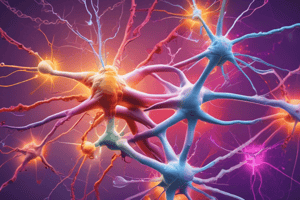Podcast
Questions and Answers
When a neuron is stimulated, ______ channels in the cell membrane open.
When a neuron is stimulated, ______ channels in the cell membrane open.
ion
Neurons have a resting membrane potential of about - 70 ______.
Neurons have a resting membrane potential of about - 70 ______.
mv
The influx of ______ ions causes the membrane potential to become more positive.
The influx of ______ ions causes the membrane potential to become more positive.
Na+
If the depolarization reaches a certain ______, it triggers an action potential.
If the depolarization reaches a certain ______, it triggers an action potential.
The action potential is an all or nothing response that travels down the ______, leading to release of neurotransmitters at the synapse.
The action potential is an all or nothing response that travels down the ______, leading to release of neurotransmitters at the synapse.
During an action potential, the membrane potential becomes more positive due to the influx of ______ ions.
During an action potential, the membrane potential becomes more positive due to the influx of ______ ions.
After the peak of the action potential, ______ channels open, allowing the ions to flow out of the cell.
After the peak of the action potential, ______ channels open, allowing the ions to flow out of the cell.
The outflow of positive ions helps to restore the ______ membrane potential.
The outflow of positive ions helps to restore the ______ membrane potential.
During hyperpolarization, the inside of the neuron becomes more ______ compared to the outside.
During hyperpolarization, the inside of the neuron becomes more ______ compared to the outside.
The combined action of ______ outflow and Na+/K+ pump resorts the original ion concentration gradients.
The combined action of ______ outflow and Na+/K+ pump resorts the original ion concentration gradients.
Voltage-gated ______ channels open, allowing K+ ions to leave the cell, making the inside more negative.
Voltage-gated ______ channels open, allowing K+ ions to leave the cell, making the inside more negative.
Sometimes ______ channels open, allowing Cl- ions to enter the cell, contributing to the negative charge inside.
Sometimes ______ channels open, allowing Cl- ions to enter the cell, contributing to the negative charge inside.
Hyperpolarization makes it less likely for a neuron to fire an action ______.
Hyperpolarization makes it less likely for a neuron to fire an action ______.
The membrane potential moves further away from the ______ needed to trigger an action potential.
The membrane potential moves further away from the ______ needed to trigger an action potential.
The resting membrane potential returns to a value of around - ______ mv.
The resting membrane potential returns to a value of around - ______ mv.
Flashcards are hidden until you start studying
Study Notes
Depolarization Process
- Neurons have a resting membrane potential of approximately -70mV, where the inside of the cell is negatively charged compared to the outside.
- When a neuron is stimulated, ion channels in the cell membrane open, allowing ion movement.
- Sodium (Na+) ions rush into the neuron, causing an influx of positive charge.
- The influx of Na+ ions leads to depolarization, which is the change in membrane potential towards a more positive state.
- If the depolarization reaches a certain threshold, it triggers an action potential.
Action Potential
- The action potential is an all-or-nothing response that travels down the length of the axon.
- The action potential leads to the release of neurotransmitters at the synapse.
Depolarization
- Neurons have a resting membrane potential of around -70mV, with the inside of the cell being negative compared to the outside.
- When a neuron is stimulated, ion channels in the cell membrane open, allowing sodium (Na+) ions to rush in.
- The influx of Na+ ions causes the membrane potential to become more positive, and if it reaches a certain threshold, it triggers an action potential.
- The action potential is an all-or-nothing response that travels down the axon, leading to the release of neurotransmitters at the synapse.
Repolarization
- During an action potential, the membrane potential becomes more positive due to the influx of sodium (Na+) ions.
- After the peak of the action potential, potassium (K+) channels open, allowing K+ ions to flow out of the cell and restore the negative membrane potential.
- The membrane potential returns to its resting state, around -70mV, through the combined action of K+ outflow and the Na+/K+ pump, which restores the original ion concentration gradients.
Hyperpolarization
- During hyperpolarization, the inside of the neuron becomes more negative compared to the outside due to the movement of potassium (K+) ions out of the cell or chloride (Cl-) ions into the cell.
- Voltage-gated potassium channels open, allowing K+ ions to leave the cell, making the inside more negative.
- Sometimes, chloride channels open, allowing Cl- ions to enter the cell, contributing to the negative charge inside.
- Hyperpolarization makes it less likely for a neuron to fire an action potential because the membrane potential moves further away from the threshold needed to trigger an action potential.
Studying That Suits You
Use AI to generate personalized quizzes and flashcards to suit your learning preferences.




